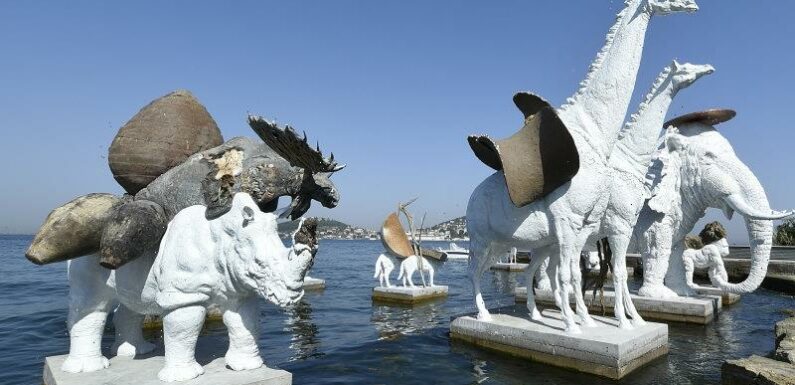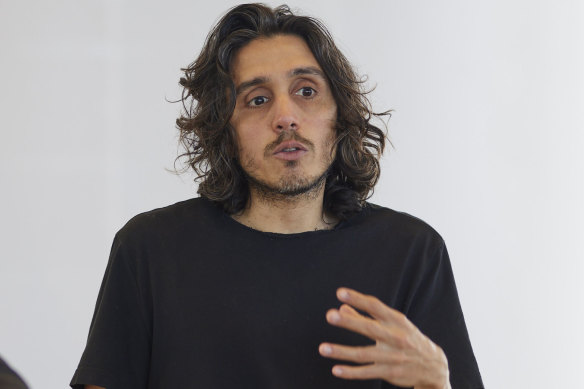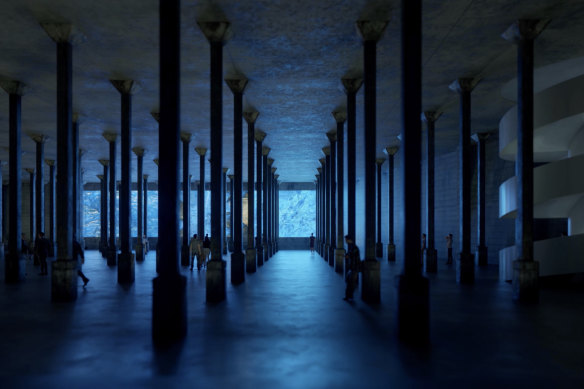
If visitors entering the subterranean Tank gallery at the Art Gallery of NSW’s expansive new wing are rendered speechless, then Adrian Villar Rojas will be a “deeply happy artist”.
The Argentinian sculptor hopes visitors will engage with his otherworldly environment of light, shadow and sculpture in the World War II-era gallery of the new Sydney Modern building with a special intensity.
Adrian Villar Rojas at the Art Gallery of NSW on Monday.Credit:AGNSW
Last week the media-shy Rojas previewed his art commission installed in the cavernous showpiece exhibition space converted from a World War II fuel tank.
The new wing opens this Saturday and is located next door to the gallery’s late 19th-century sandstone home in The Domain, with Villar Rojas the first artist invited to take over the Tank gallery. Installations are to change every year.
Arts Minister Ben Franklin says Rojas’s work is breathtaking, visceral and undefinable.
“I literally stood there with my mouth open for minutes just taking it all in,” he says. “No one will have ever seen an exhibition like this. A tiny number of people will have seen art like this before.”
The Tank Gallery Credit:AGNSW
The starting point for Villar Rojas’s The End of Imagination, came four years ago when the artist first descended a manhole ladder into the fuel bunker that had lain disused for decades. Inside was an underground space, its concrete cap held up by 125 columns, rising seven metres high.
Villar Rojas says he immediately sensed the power and potential of the underground realm of the oil tank, describing it as portal to human stories of conflict. He notes that exhibition spaces such as The Louvre in Paris, or the Arsenale in Venice, are similarly bound up with histories of conflict, conquest and revolution.
“I love that visitors are entering a space that has long been a secret, and it’s important that visitors get to discover this space as their own secret too, without knowing too much in advance,” Rojas says.
“The installation I have created combines the architecture of the oil tank with moving lights that rove and sweep the space like sentient beings, slowly viewing and revealing many thousands of details. It is very much an experience that unfolds in time, in which not everything is known immediately.”
Rojas’ installation on the shore of Buyukada in Turkey, where Trotsky spent four years in exile.Credit:Getty
In 2017 Rojas created an installation of human and animal figures, food and artifacts on the roof of the Metropolitan Museum of Art. Two years earlier he famously installed a dreamlike installation on the shores of the Turkish island where Leon Trotsky was exiled, to evoke migrant journeys and the passage of civilisations.
On entry to the Tank gallery, Franklin says audiences will encounter five enormous sculptural forms that are “both natural and yet mechanical”. “They are like something from the past, a million years ago, and at the same time from the far future,” Franklin says. “They look incredibly threatening and at other times incredibly comforting.
“The light is constantly changing and evolving and the sculptures almost seem alive. It’s fascinating to watch, and audiences are going to be amazed, excited, inspired and a little taken aback.”
For the installation, the artist’s team created digital simulations of fantasy worlds and placed virtual sculptures within them.
Building the software program called the Time Engine took 15 months.
This was followed by an “exceptionally intense phase” of physical making, which spanned nine months in the workshop.
Virtual sculptures were made real using composites of metals, plastics, concrete, soil, glass, salt, wax, resin, tree bark, metal, salvaged auto parts, recycled plastics, and other organic and inorganic materials.
The overall effect of The End of Imagination is a deeply visceral experience.
”All my exhibitions are dynamic entities and that is very true of this project,” Rojas says. “I have just returned to Sydney, and it has been rewarding to see people spending time in the space, watching as the moving lights reveal the many details into which we poured so much love and care.
“Ultimately time is the most generous thing a visitor can offer, and I hope these objects reward all the seconds people give them.”
A cultural guide to going out and loving your city. Sign up to our Culture Fix newsletter here.
Most Viewed in Culture
From our partners
Source: Read Full Article


